
A HAL1x Multiprocessor supports 16 in x 16 out audio, with 8 in x 8 out on balanced analog connections, and another 8 in x 8 out through RADs. It is unique among the HAL Multiprocessors because it carries an Expansion Bus, which can increase the I/O up to 512 in x 512 out by adding up to 32 daisy-chained Expanders to a single HAL1x. A few to hundreds of more gain-sharing mic inputs are possible with AM Automixers. HAL1x's DSP brain has over 5 times the DSP horsepower of the popular Rane RPM 88.
The Expansion Bus supports up to 32 daisy-chained Expanders in any combination. The Expansion Bus requires shielded CAT 5e (or better) cable with RJ-45 connectors. Daisy-chaining with single cables to and from each Expander connects all the I/O and processing.
The bus supports 512 channels in and 512 out, although designers need not worry about wiring channels along the bus — this is automatically done within Halogen software. The Resources window in Halogen displays the number of channels in use and updates as you draw the audio wiring. Latency hops on the bus are 750 nanoseconds per hop. Thus, daisy-chaining 32 Expanders provides a maximum latency of 22.4 microseconds. See the Latency graphic below to add up the latency of any given path through the HAL1x, EXPs, RADs, the DSPs and converters.
Thirty-two Expanders maximum, in any order can be daisy-chained. For example, 16 EXP3x and 16 EXP5x Expanders daisy-chained, provides 128 outputs (8 out times 16), plus 192 mic/line/line-plus inputs (12 in times 16).
Some examples max out the Expansion Bus:
Each Expansion Bus cable can be 100 meters long (300 feet). This permits spreading Expanders across different locations or equipment rooms. Yet only a single HAL1x is required at the head-end of the daisy-chain. Star topologies are not supported — do not use Ethernet switches, they will not work. And since the EXP3x & EXP5x contain their own DSP, no DSP resources in the HAL1x device are used; thus adding these devices adds DSP resources to the HAL1x System.
Gigabit Ethernet Media Converts are supported. Thus, using multimode fiber, one can separate Expanders up to 2 kilometers (1.2 miles). Singlemode fiber distance goes up to 12 km (7.5 miles). The Expansion Bus is Ethernet Layer 1 only — there are no MAC and no IP addresses involved, therefore dedicated unmanaged media converters must be used.
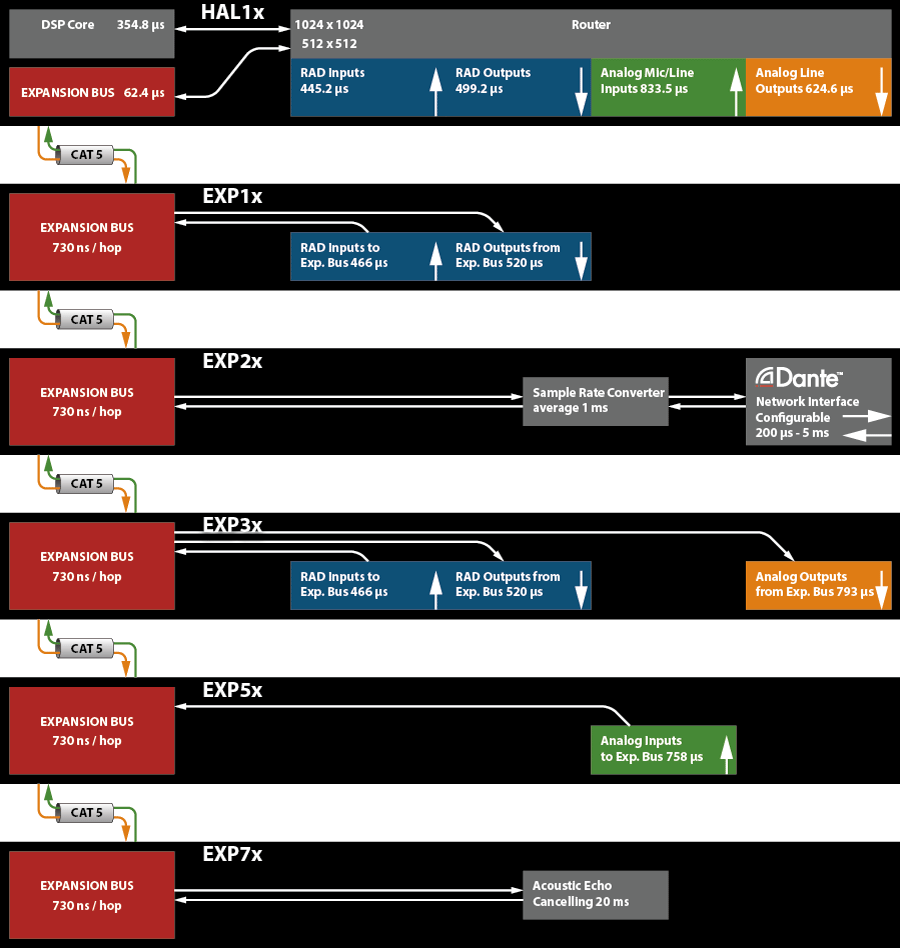


The EXP1x adds eight RAD ports to a HAL1x via the Expansion Bus. The EXP1x requires a HAL1x to operate. DR remotes are also supported on any RAD port, so the EXP1x also adds additional DR remotes. The graphic below shows most of the range of RADs and DRs that connect with shielded CAT 5e cable (or better). 512 inputs and 512 outputs are possible if 32 EXP1x Expanders are cascaded to a HAL1x.
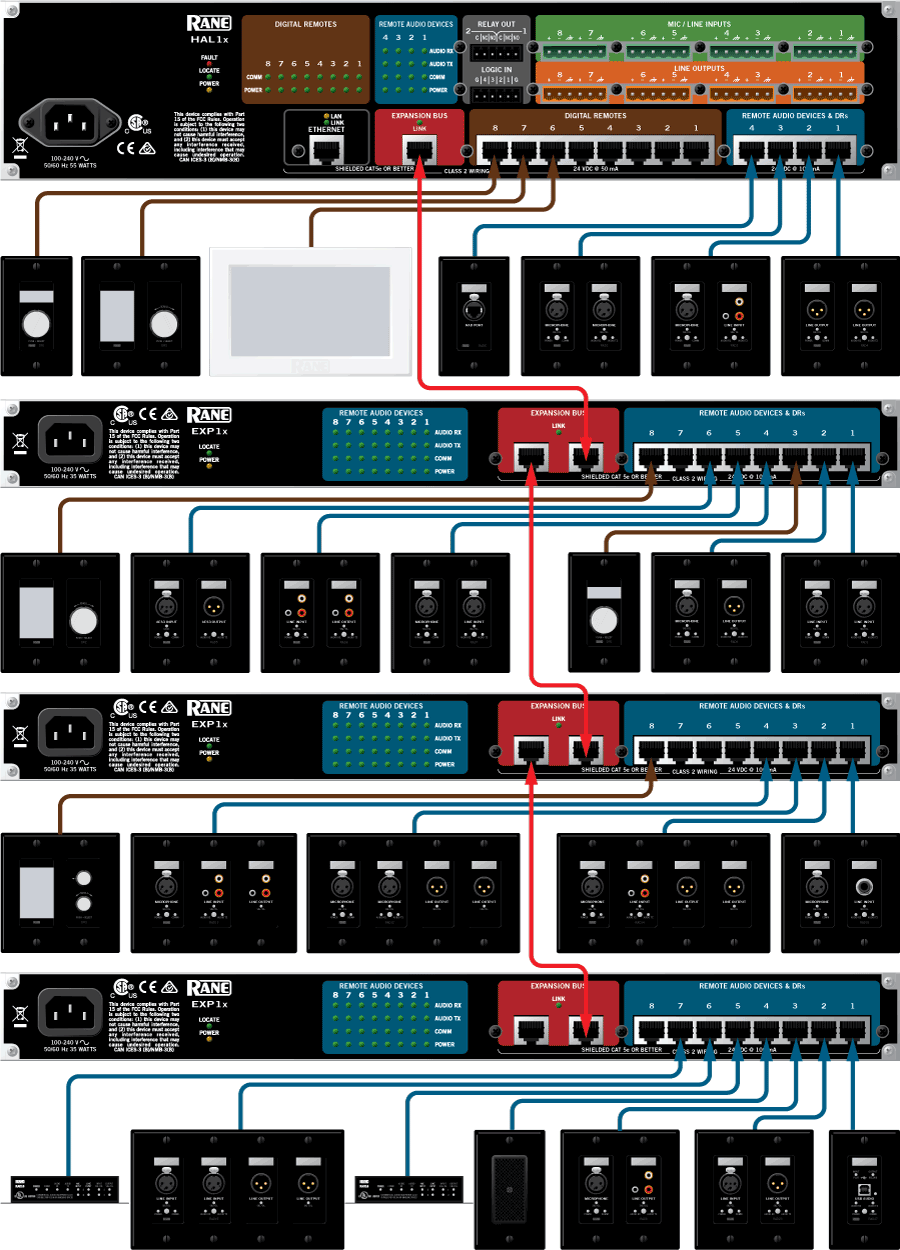


 The EXP2x is an input/output expander that enables the HAL1x to transmit 32 and receive 32 audio channels from a Dante™ network. Applications abound in houses of worship, installed sound, performing arts venues, education and corporate environments – anywhere a Dante network is used. The EXP2x also allows connecting a Dante network between multiple independent HAL1x systems.
The EXP2x is an input/output expander that enables the HAL1x to transmit 32 and receive 32 audio channels from a Dante™ network. Applications abound in houses of worship, installed sound, performing arts venues, education and corporate environments – anywhere a Dante network is used. The EXP2x also allows connecting a Dante network between multiple independent HAL1x systems.
Built-in sample rate converters convert the 44.1, 48, 88.2 or 96 kHz sample rate on the Dante network to the HAL’s 48 kHz clock domain.
Daisy-chain up to 16 EXP2x Expanders to a single HAL1x to max-out at 512 x 512 channels on both a single cable on the Dante network and the HAL1x’s Expansion Bus. The HAL1x is capable of 32 Expanders on its bus, so the EXP2x can be combined with other Expanders. For example, use 16 EXP2x Expanders with 512 input and 512 output channels, and then put on another 16 EXP3x Expanders for more outputs.
The EXP2x is equipped with a Secondary Dante port for either Redundant Mode or Switch Mode. Use Dante Controller software for all network audio and EXP2x settings via its Brooklyn II card.
Front panel and Halogen software indicators for Dante connection, network status, flow active, and audio signal present aid troubleshooting. Dante Controller provides all network setup, monitoring, control, diagnostics and troubleshooting beyond compare; while Halogen reads, but does not edit the Dante setup, simplifying which software to use and eliminating conflict.
Dante provides a no-hassle, self-configuring network with ultra-low latency, while providing a true plug-and-play digital audio network using standard Internet Protocols on existing infrastructure — without requiring a dedicated network. The technology is built on global networking standards, making signal distribution more flexible, cost-effective and user-friendly and has been used at some of the largest live events and sophisticated installations worldwide.
Unlike all other Rane EXP devices, names and all the settings inside the EXP2x are read-only in Halogen software. The only thing you can do in Halogen with the EXP2x is click the Locate button to flash a light on the front or rear to identify the device. Configure the EXP2x Dante device name, audio channel names, audio routing, latency, sample rate, secondary Ethernet port mode, and every EXP2x setting using Dante Controller software, available free from Audinate.
Once you’ve set the EXP2x settings on a live Dante system using Dante Controller and talked live to the HAL1x using Halogen, all EXP2x settings and names are read from the Dante network and saved inside your HAL and the Halogen configuration file. These settings remain saved and intact in the EXP2x’s Dante cards (a Brooklyn II card from Audinate). You cannot edit these settings in Halogen. There is only one place to make changes: Dante Controller – it is well-equipped for the job. Read the Dante Controller User Guide from Audinate’s website. It is worth your time.
To connect, route or subscribe audio channels between any two Dante devices, all devices must be configured with the same sample rate using Dante Controller software. Because Rane has chosen to disable editing of all Dante network settings inside Halogen software, this creates a clear distinction between where to go to configure or change a system. And there is no concept of pushing settings from Rane to Dante. All Dante audio network settings are managed, set up and configured using Dante Controller.
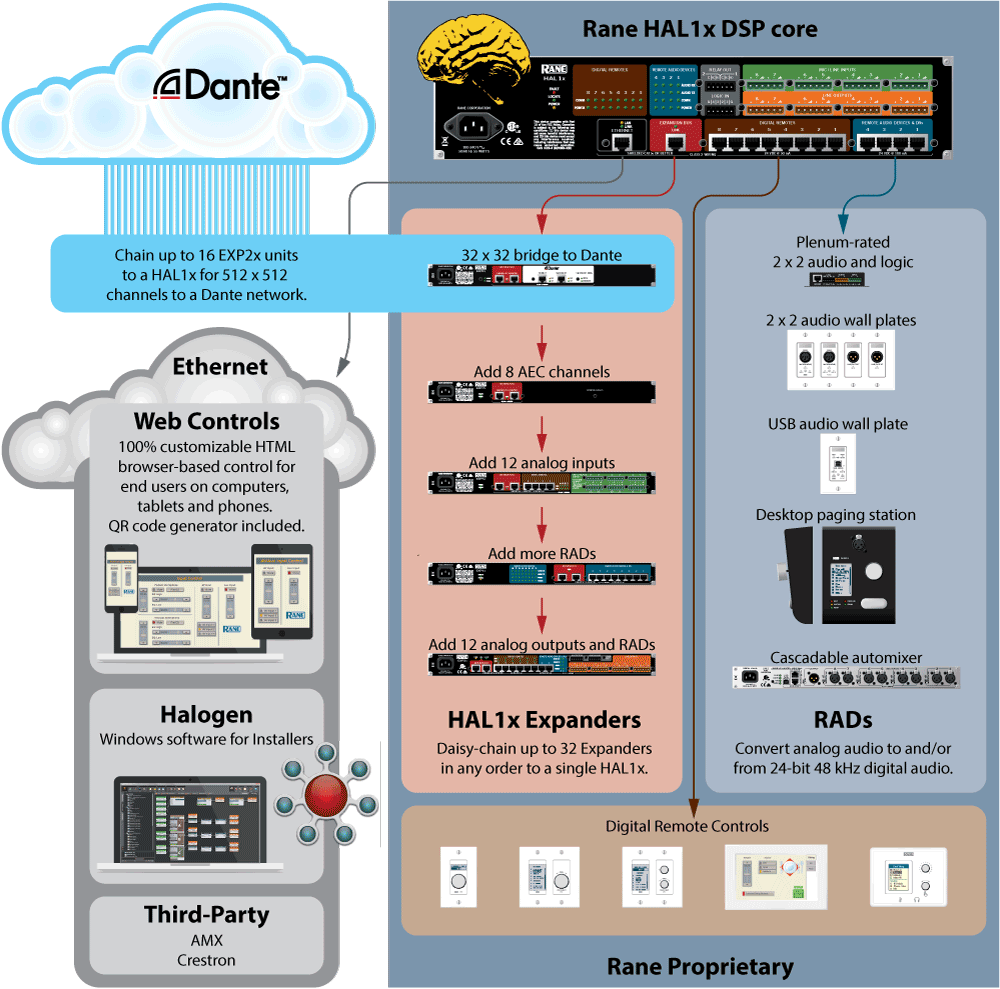
Dante Subscriptions & Flows – When you route a receive and transmit audio channel using Dante Controller’s grid, Dante creates a single, unicast Flow. This audio route is called a subscription. A single Dante Flow can contain multiple audio channels, typically 4 audio channels. The number of channels in a Flow can change as you add more subscriptions, change latencies, or after you restart your network. It’s all about Dante optimizing network bandwidth when it can as you subscribe audio channels between devices. Dante Controller lets you view and manage Flows which may rarely be required.
When clicking the routing grid in Dante Controller, Dante only creates unicast flows. If you need audio to be received by two or more devices, you must manually configure multicast Flows within Dante Controller. See the Dante Controller User Guide for details such as using IGMP in managed switches to manage networks requiring many multicast Flows. Also note that the different Audinate Dante implementations support different number of maximum Flows. The Audinate Brooklyn II card inside the EXP2x supports 32 Flows in and 32 Flows out, maximum. Unlike unicast Flows, by definition and default, multicast Flows use network bandwidth on the entire network, even when no receivers are set to listen.
EXP2x Firmware. The Brooklyn II card inside the EXP2x has its own firmware that is a Rane-customized file specifically for the EXP2x. Audinate does not have this, or any firmware file; the Dante manufacturer controls the firmware file. Yet, like all HAL System firmware, the EXP2x Dante card’s firmware is included within the Halogen software. Thus, only by updating Halogen software is it possible to update the firmware in the EXP2x Dante card. All HAL hardware device firmware is stored in the HAL device. See the Halogen Desktop Help or Mobile Help entry “Understanding the Role of Firmware in the HAL System.”
Answers to this and many other Dante questions are found here. The Cisco 300 Series Ethernet switches are available in many varieties, such as the 10-port, SG300-10. They are very affordable, managed, and some offer PoE versions if needed. If you use an Ethernet switch with “Green” Energy-Efficient Ethernet (IEEE 802.3az) turn off this feature. This green technology can delay packets hundreds of milliseconds which will stop all Dante audio from working.
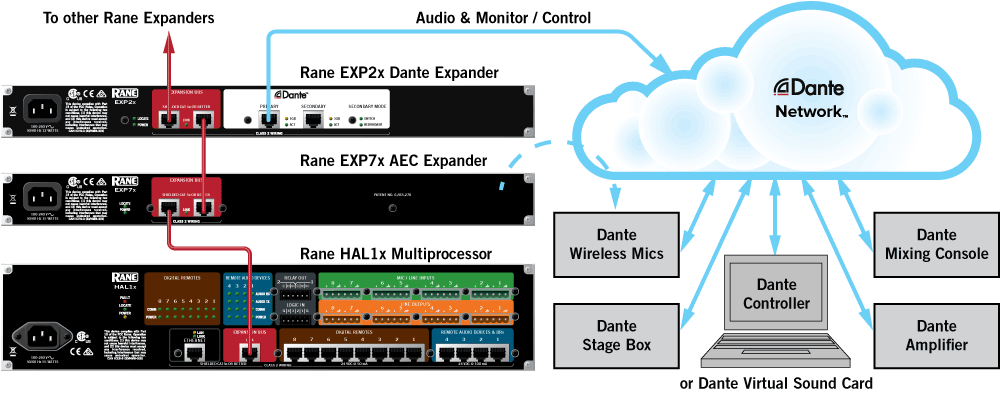
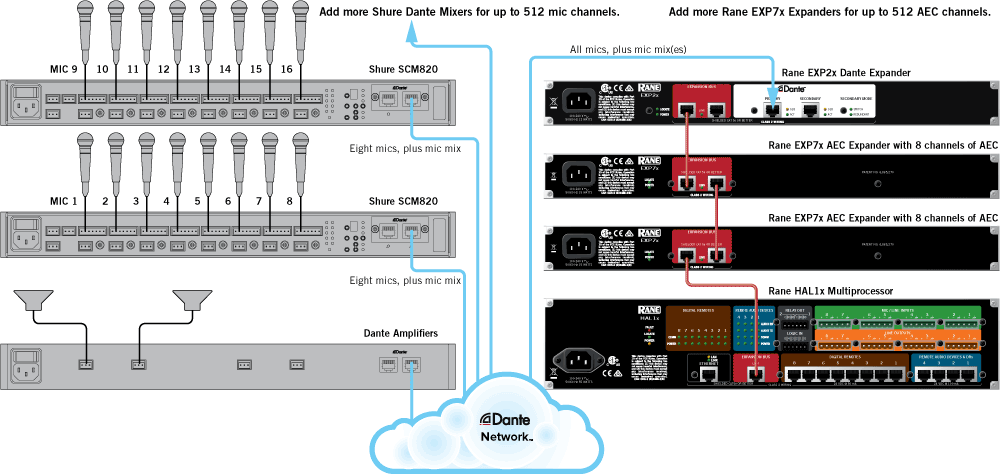
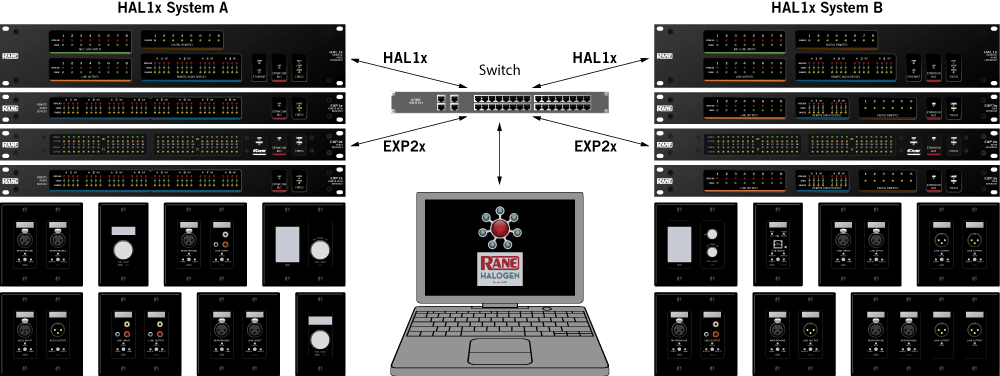
Audinate revolutionizes AV systems to customers to thrive in a networked world. Audinate’s patented Dante media networking technology has been adopted by the leading manufacturers in the professional audio/visual industry. Dante is used extensively for live performance events, commercial installation, broadcast, recording and production, and communications systems. Audinate offices are located in US, United Kingdom and Australia. Visit www.audinate.com for the latest news and information on the company. Dante is Digital Media Networking Perfected.


The EXP3x is an 8-channel analog output & DSP expander for the HAL1x (required for operation). Two RAD ports make it a 4-input, 12-output audio device — depending on which two RADs are connected. Thus, 32 daisy-chained EXP3x Expanders provide 256 discrete zone outputs maximum, including output compression, parametric EQ, two levels of paging and background music. Also, eight logic outputs and six DR remote ports are included. Therefore, 32 daisy-chained EXP3x Expanders would provide 64 RAD ports, 192 DR ports and 256 logic outputs.
The dedicated DSP for each of the eight analog outputs offers two signal processing choices independently selectable per output. When you need background music, paging and emergency paging on an output, select the Zone Output processing set. This provides a Zone Processor block, and an Emergency Zone in addition to a Compressor and a 5-band parametric EQ with high- and low-cut filters. When Line Output is selected, the compressor and parametric EQ are available without the zone processing block and emergency paging blocks.


The EXP5x is a 12 Mic/Line/Line-Plus input & DSP expander for the HAL1x. It also supplies four DR ports, useful for adding source selection and/or volume control remote controls. Each of the 12 inputs independently supports either dynamic mic, 48V phantom mic, +4 dBu line-level, or Rane’s Line-Plus input. Line-Plus accepts -10 dBV unbalanced Left/Right Monoed together on the “+” and “–” ports, respectively. For stereo unbalanced sources, Line-Plus allows connecting the stereo RCA left tip conductor to the “+” terminal, the RCA right tip to the “–” terminal, and both RCA shields to the EXP5x Euroblock ground. Select Line-Plus in Halogen and you get a properly monoed audio channel.
Known hardware issue: Some EXP5x devices with serial numbers below 930856 have the rear panel LOCATE and POWER text swapped. Thus, the Locate button is actually indicating that the power is on, while the Power indicator will flash after you click Halogen’s Locate button. An easy workaround is using the front panel Power & Locate indicators which are correct. New units are correct. The corrected rear panel looks like this.


The Rane EXP7x Expander for the HAL1x provides eight channels of full-featured, drag and drop Acoustic Echo Cancellation (AEC). Each channel of AEC can be added to any HAL1x system input and route to any Halogen DSP block, including the gain-sharing automixer, manual mixer, regular Room Combine block, or Conference Room Combine block. Chain up to 32 EXP7x units to a HAL1x for 256 assignable AEC channels.
Because EXP7x AEC channels are not associated with a particular hardware input, preset recall can re-assign an AEC resource across inputs / rooms as required. Drag and drop AEC supports the typical one-AEC-per-microphone configuration. With optimum acoustics, mic and loudspeaker placement, or with rarely used mics (such as audience mics) it allows mixing more than one mic into a single AEC channel, significantly reducing cost.
A Remote Audio Device (RAD) provides analog to digital conversion at the wall.
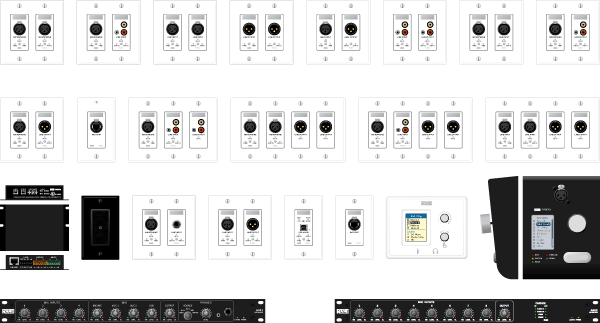
Three Digital Remotes simplify end user control and eliminate installer brain fatigue. Use Digital Remotes for volume control, preset recall, source selection, or resetting or toggling system states. All offer customizable backlit LCD screens for intuitive end user labeling. Home run shielded CAT 5e (or better) connections to a HAL or EXP eliminate addressing, external power, and the need to test the cables. Each is available in white, ivory or black, and fit in standard electrical boxes.
The DR4 Logic I/O Expander adds more logic to any HAL for external switches and pots:
The DR5 Switch Controller adds more logic to any HAL, accepting external switches and driving LEDs on a room combine panel.
The DR6 is a fully customizable touchscreen remote for the HAL family. It supports multiple pages or tabs and any set of levels, toggles, selectors and/or commands on the 7-inch LCD display.

The maximum length for CAT 5e cable between ethernet devices is 100 meters.
Shielded CAT 5e between a HAL or EXP and a RAD (carrying 4 channels of digital audio) can run up to 150 meters.
Shielded CAT 5e between a HAL or EXP and a DR (carrying control information) can run up to 300 meters.
It is possible to extend these lengths by increasing distance between the HAL and Expanders. Up to 32 Expanders can daisy-chain from a single HAL, and each can be up to 100 meters apart. For greater distance, off-the shelf Gbit Ethernet media converters are supported. Multimode fiber can run up to 2 kilometers, and singlemode fiber can run up to 12 kilometers.
Phone the Rane Factory at 425-355-6000, 8:30 AM to 5 PM USA Pacific Time, Monday to Friday.
